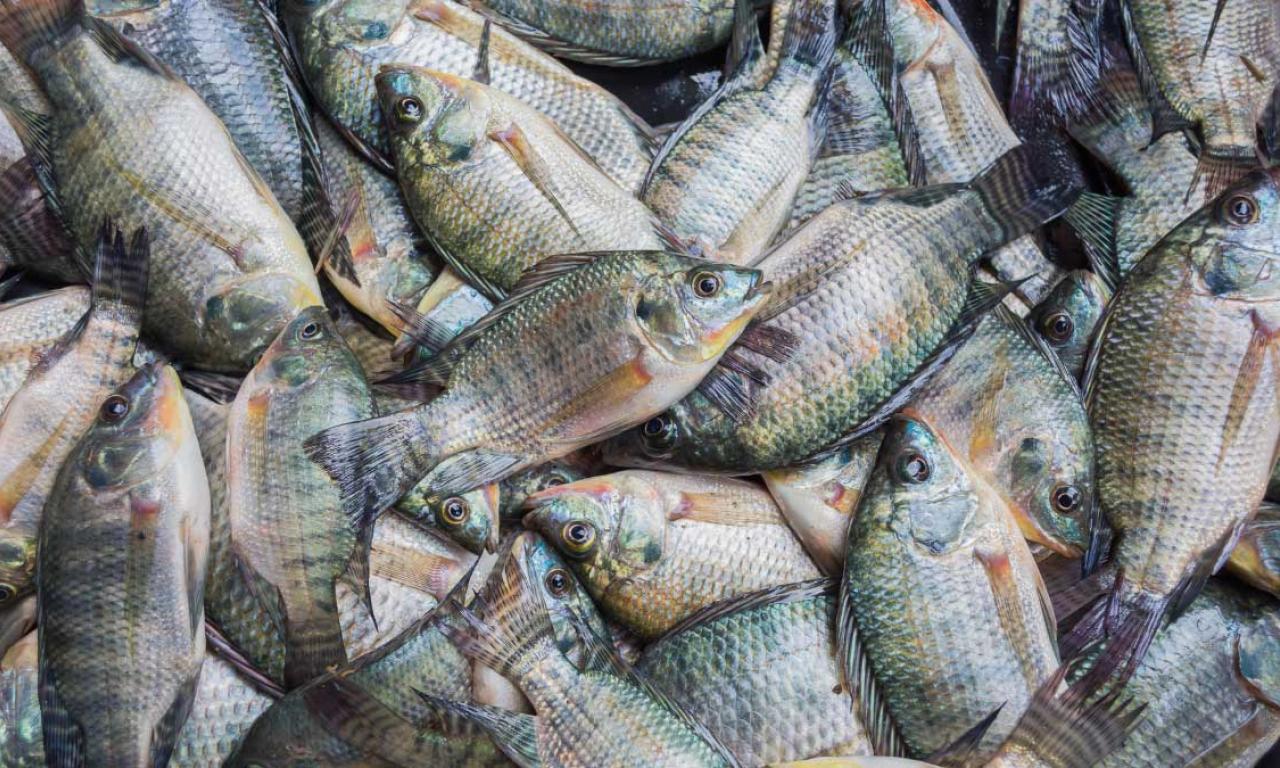
- Utilization of incentives provided by the Indian government at the central and state levels to small-scale farmers as well as commercial enterprises for tilapia farming could lead to meeting government targets of increasing employment generation and foreign exchange earnings, in addition to increased fish production and consumption.
- Some of the factors to increase production are the availability of quality seeds, building awareness and knowledge of the species among farmers and consumers as well as enhanced accessibility to markets.
Tilapia, native to Africa and the Middle East and popularly known as “aquatic chicken”, is widely farmed in about 145 countries worldwide. Once considered “a poor man’s fish”, tilapia has emerged from mere obscurity to be one of the world’s most productive and internationally traded food fish.
It is a versatile species, being hardy and quick growing, can be farmed in a wide array of culture environments and systems, ranging from extensive rural subsistence, low-input pond culture using agriculture by-products to intensive systems such as recirculating aquaculture systems (RAS), Biofloc systems, raceways and so forth.
Though there are about 70 species of tilapias, commercial tilapia production is concentrated mainly on three species, of which Nile tilapia (Oreochromis niloticus), has for many decades been responsible for the significant increase in global tilapia production from freshwater aquaculture due to its short generation time, high tolerance to variable water quality and diseases and ability to grow in diverse farming systems
The last three to four decades have seen significant developments in the farming of tilapias worldwide. While in the initial years of its farming history, tilapia was mostly consumed within producing countries in Asia and Africa, in recent times there has been a growing acceptance and consumption of tilapia in non-traditional countries such as the United States, Canada and Europe as well as Central and South America, thus making tilapia an exportable commodity
Given the increasing commercialization and continuing growth of the tilapia industry, tilapia is not only the second most important farmed fish globally next to carp but is also described by some as the most important aquaculture species of the 21st century. Tilapia farming has achieved much faster growth than the aquaculture industry and most farmed aquatic species groups in the past two decades. The average production growth of farmed tilapia reached 10.1 % between 1999 and 2018 with production increasing from 3.49 million tons in 2010 to 6.03 million tons in 2018.
This multifold increment in farmed tilapia production over the past three decades can be attributed to technological innovations, such as the successful development and dissemination of genetically improved strains, mono-sex seed production, improved farming practices and an overall increase in demand for the species.
Changes in consumer preferences for boneless tilapia fillets, its relative easiness to cook and availability of ready-to-eat products as well as the affordability of tilapia have all contributed to this rapid growth in demand from all consumer segments, from low-income consumers in developing countries in Asia and Africa to high-income consumers in developed countries.
The development of Genetically Improved Farmed Tilapia (GIFT) – through traditional selective breeding techniques to improve commercially important traits – by WorldFish and partners is a major milestone in the history of not only tilapia aquaculture but also the aquaculture of tropical finfish as a whole. WorldFish estimates that more than 50 percent of global tilapia production is from GIFT and GIFT-derived strains.
Fish consumption and production trends in India

In India, fish consumption is steadily increasing, and the government has set a target of achieving annual per capita consumption of 12 kilograms by 2024-25 against an estimated consumption of 5.6 kilograms in 2018-19. To achieve this goal, the government of India has set a target of producing 22 million tons of fish by 2024-25 as against a production of 13.75 million metric tons in 2018-19 – an increase of about 8 million metric tons – to meet the demand of a growing population and also increasing per capita consumption of fish. Much of the increase in production is projected to come from inland aquaculture.
Over the past three decades, inland aquaculture production in India has experienced accelerated growth, making this sector a major player in aquatic food production and supply to both domestic and export markets. Indian major carps have been the main farmed species, though minor carps and catfish such as Pangasius also contributed significantly to Indian farmed fish production, apart from shrimp.
Given the diversified production systems encouraged by the government – from farming of fish in cages to intensive production systems such as recirculating aquaculture (RAS) and Biofloc systems, in addition to traditional pond production systems – an urgent need is felt to identify a species that is amenable to farming in these varied systems, besides Pangasius
Experience from other countries has shown that tilapia is a species suitable for these intensive systems, in addition to farming in low-input pond culture. The government agencies in India are keen to increase production from reservoirs by farming fish in cages. At present, the species farmed in these cages are mostly Pangasius as carp have not yet shown potential for farming in cages. Under these circumstances, Nile tilapia can play an important role in increasing production – both from traditional farming and from intensive/commercial production systems – and contribute to increased exports from freshwater aquaculture, which so far have been negligible.
To reach projected targets of production, increased employment generation and foreign exchange earnings, various incentive schemes for seed producers, growers and processors offered by the central and state governments in India, such as Pradhan Mantri Matsya Samapada Yojana (PMMSY), can also be tapped on to increase tilapia production.
Tilapia in Indian aquaculture
In the past, there was a misconception that tilapia is a pest in Indian aquaculture due to the introduction of the wrong species – Mozambique tilapia – in 1952. The culture of this species was met with failure due to its undesirable characteristics and production of small, low-value fish at harvest. As a result, tilapia farming was banned in 1959.
With subsequent studies indicating the potential of farming Nile tilapia, the ban was lifted in 2009 and the government of India formulated guidelines for responsible farming of the species. State governments were mandated to monitor, control and surveil hatchery, nursery and farming facilities. Biosecurity and licensing are the key aspects of the guidelines and the state governments are authorized to issue licenses and register farms.
Under the guidelines, some private hatcheries, and companies as well as the Rajiv Gandhi Centre for Aquaculture (RGCA) were initially allowed to import commercially viable tilapia strains from overseas and set up multiplication centers and hatcheries in the country. In 2019–20, close to 94 million fry was produced by about 11 licensed and more than 25 unauthorized tilapia hatcheries. The major strains produced by licensed hatcheries in India were GIFT, Chitralada and Golden.
While there is a steady increase in the production of tilapia in states like West Bengal, Maharashtra, Madhya Pradesh, Chhattisgarh, Bihar, Jharkhand and Kerala, the major hub for commercial aquaculture production in India, Andhra Pradesh, farms primarily Indian carps.
Farmers are not keen on tilapia farming in the absence of an assured market for large production. Some of the main factors for low production of tilapia in India are the non-availability of quality seeds, lack of awareness and knowledge of the species among farmers and consumers as well as limited access to markets.
Looking forward

There is untapped potential for increasing fish production through the farming of tilapia in India. What is needed to harness this potential is to create awareness among small-scale farmers and homestead growers as well as consumers of the multiple benefits of producing and consuming tilapia; ensure the availability of quality seed to both small-scale and large-scale commercial farmers; and provide incentives to seed producers, growers and exporters.
With an increasing demand for tilapia in international markets, there is no better time for commercial producers to enter tilapia farming. The government of India has set a target of doubling foreign exchange earnings from the export of aquatic foods by 2024-25. Presently, only small quantities of freshwater fish are exported. The government targets can be achieved by encouraging more entrepreneurs to be involved in the commercial-scale production of tilapia.
In 2011, RGCA – under the aegis of the Marine Products Development Authority of India (MPEDA) – collaborated with WorldFish to establish a satellite breeding program for GIFT. However, the seed produced was minimal and not able to meet the demand of even a small number of farmers.
Some private entities have been importing seeds of other strains of tilapia such as Chitralada and Golden. If India is to attain its potential in terms of increasing production and exports through the farming of tilapia, there is a need to establish brood banks, multiplication centers, licensed hatcheries and nurseries, among others. There is also a need to establish breeding programs for strains other than GIFT for faster and sustained scaling.
Timely interventions by the government of India in terms of creating awareness of the benefits of farming and consuming tilapia, along with appropriate policy changes and financial incentives to farmers and entrepreneurs would, undoubtedly, accelerate the growth of tilapia production in India, leading to increased domestic consumption and overseas exports, in addition to generating employment for the local people.
